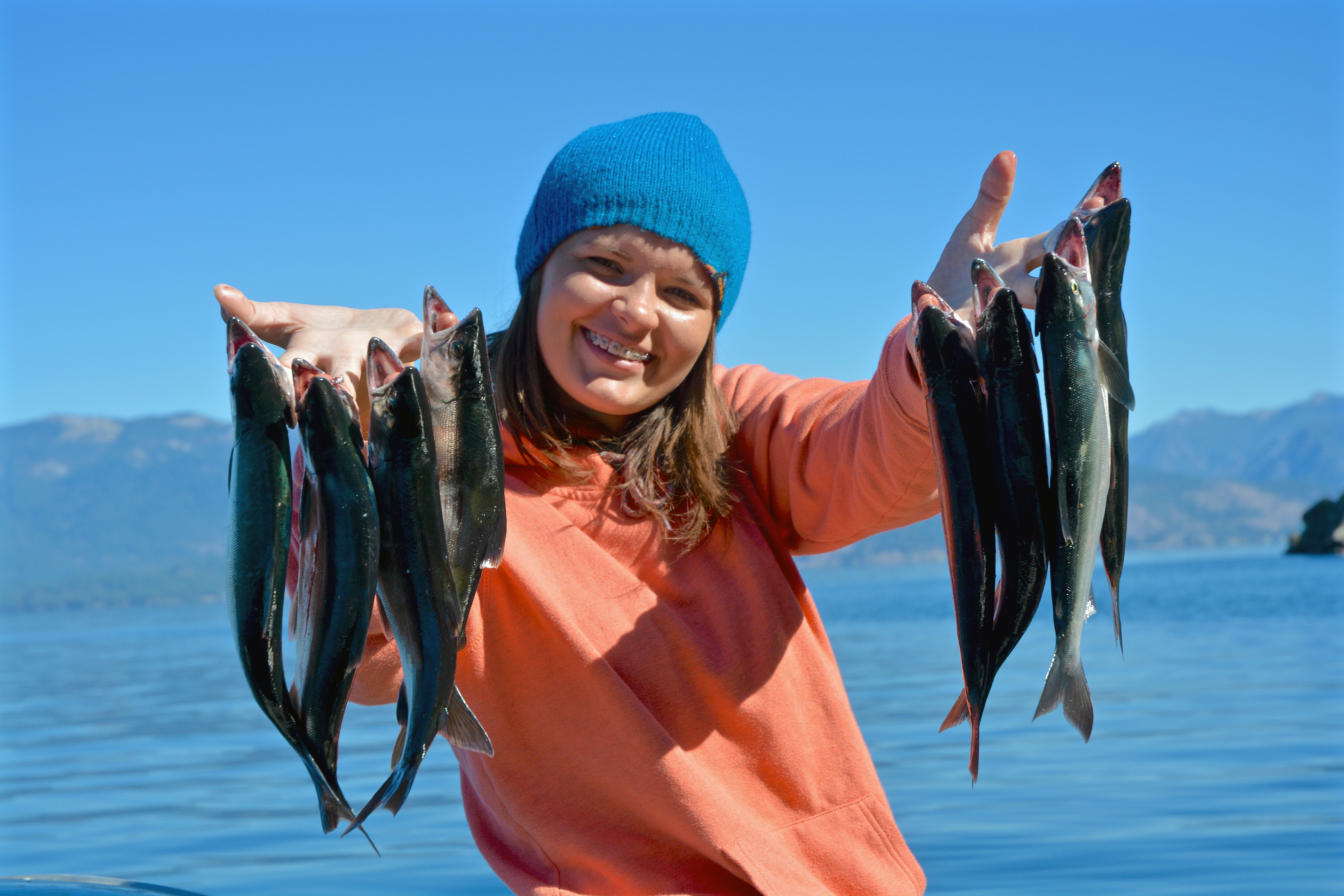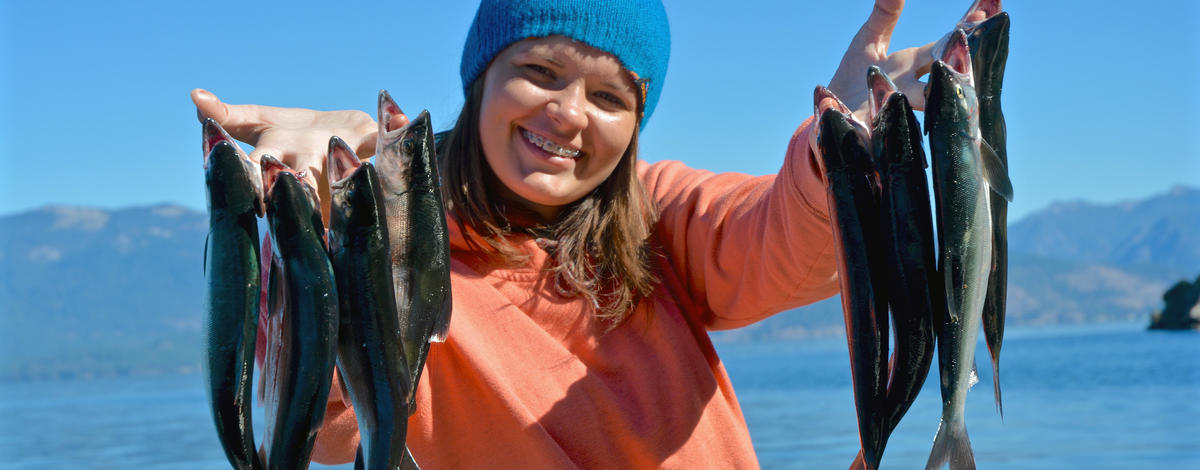Kokanee provide some great fishing opportunities across Idaho and can provide lots of action and a great-tasting fish, but they’re a little different than many other Idaho game fish.
Kokanee have a reputation for being a boom-or-bust species: abundant one year, and scarce the next. Just because the fishing was fantastic at a certain reservoir or lake last year doesn’t mean it will be again when you go fishing the following year.
Fish and Game biologists have a number of tools to manage kokanee populations for size and abundance, but it’s a tricky balancing act — and they are ultimately constrained by the natural cycles that cause to fish to flourish some years and be scarce in others.
Kokanee populations are typically a combination of stocked fish and those naturally produced by spawning fish, but unlike trout, all kokanee are stocked as fingerlings, so biologists have to hope conditions are right to produce an abundant class of adult fish for anglers.
The key for kokanee anglers is to take advantage of fishing when populations are booming, and to take heart knowing that even in a bust cycle, the next boom likely isn’t far away (and the fishing is often best on the rebound).
With kokanee fishing in full swing in southern Idaho, and northern Idaho following close behind, here are some waters across the state that appear to be on the upswing, and should be worth checking out in 2020. There are also many other options for kokanee fishing in Idaho, which can be found on the Idaho Fishing Planner.
Lucky Peak Reservoir
Located about 30 minutes from Boise, Lucky Peak is a great option for a day trip for anglers in the Treasure Valley and even the Magic Valley.
The kokanee fishing in southern Idaho’s “silver triangle,” comprised of Lucky Peak and nearby Arrowrock and Anderson Ranch reservoirs, has been slower in 2020 than recent years, particularly at Anderson Ranch, where a confluence of circumstances helped created a world-class kokanee fishery from 2017 through last year.
Signs are pointing to a slower year for kokanee fishing in the “silver triangle” overall, but Lucky Peak is shaping up to be the best of the bunch.
“Lucky Peak has been somewhat of a surprise this year,” said Southwest Regional Fisheries Manager John Cassinelli. “While it has still generally been slow, anglers are finding a few kokanee and catching both this year’s age class of adults (17-18 inches) and next year’s adults (currently 8-11 inches), so that is promising.”
Deadwood Reservoir
Deadwood is a unique kokanee fishery because it is off the beaten path and provides a backcountry feel. The kokanee are typically abundant, and the bag (15) and possession (45) limits are fairly liberal — making it the perfect spot for an extended fishing trip. Deadwood serves as the primary source for early run kokanee eggs in Idaho, but biologists also manage it as a quality kokanee fishery. Last year, average fish size was good for anglers – about 13-15 inches — and the early reports from the reservoir this year are also promising.
“Access is just opening up there. Right now, only the Bear Valley route into the reservoir is accessible. But the preliminary reports from the few anglers who have made it up there are that there are good numbers of 10-12 inch fish,” Cassinelli said. “That’s by no means definitive, and we will know more in the next couple weeks.”
Lake Pend Oreille
It’s shaping up to be a good year for kokanee fishing on Lake Pend Oreille, and anglers in northern Idaho should be taking note.
Fisheries researchers in the Panhandle Region estimated that over 2.5 million kokanee occupied the lake in the fall of 2019, which is the highest count on record since the mid-1990s, and anglers are already reaping the benefits of the abundant kokanee population. Plus, a “bonus class” of four-year-old fish is boosting the kokanee fishery, both in terms of numbers and average size.
Lake Pend Oreille is home to late-run kokanee, which typically reach maturity at around three years, at which point they spawn and die. Last fall, some of the age-three fish hadn’t matured yet, and there are good signs that these fish being caught be anglers as four-year-olds, which is contributing to the quality fishing on Pend Oreille.
Biologists believe aggressive predator suppression for lake trout and walleye, coupled with low numbers of Mysis freshwater shrimp, are creating good conditions for abundant kokanee right now. You can read a more in-depth look at Pend Oreille’s 2020 kokanee outlook here.
Hayden Lake
Another option for kokanee anglers in northern Idaho is Hayden Lake. Fish and Game began stocking Hayden Lake in 2011, and it quickly became one of the more popular fisheries in the Panhandle Region. Biologists have typically managed Hayden Lake for larger kokanee and stocked it with early-run variety of the fish, which tend to grow faster than their late-run relatives. They reach maturity at two years old and attempt to spawn in the late summer and early fall.
A statewide shortage of hatchery kokanee in 2018 resulted in Hayden Lake being stocked with late-run kokanee, and anglers should expect that kokanee in the 2020 fishery may be smaller on average than they have been in recent years. On the bright side, the late-run kokanee commonly spawn at three years old instead of two, which means anglers may see more larger-than-average kokanee in 2021.
Anglers should also note that these late-run fish will have a lighter colored flesh, much like kokanee in Coeur d'Alene Lake or Lake Pend Oreille. Idaho Fish and Game returned to stocking of early-run kokanee in 2019. Here is some more information about the differences between early- and late-run kokanee.
Dworshak Reservoir
For anglers in the Clearwater Region, Dworshak Reservoir is a good option for kokanee fishing. The fishery began to rebound in 2019 after a couple of down years and is likely to remain on the upswing in 2020, although anglers might see some smaller fish this year.
“I like to say that kokanee numbers bounce up and down like a Yo-Yo. The good news is that their numbers came up fast last year after bottoming out two years ago,” said Sean Wilson, fisheries research biologist. “Fishing always seems to be best on the rebound, as kokanee grow better when there are fewer fish to compete for food with.”
According to Wilson, Dworshak Reservoir had about half a million kokanee in the 10-12 inch range in the summer of 2019, which is both larger and more abundant than normal. Based on last year’s surveys, Wilson anticipates a similar abundance of the larger two-year-old kokanee in 2020.
In April of this year, the age-2 kokanee ranged between 8 and 10 inches, and averaged about 9 inches, which is similar to the size of the age-2 kokanee at that time last year. However, how fast these fish grow is influenced by how many younger kokanee are out there, as both age-1 and age-2 fish compete for the same food. Fish and Game surveys indicated there could be about twice as many age-1 kokanee this year compared to last year, assuming average winter survival.
“This means there will be more mouths to feed and growth rates should drop in comparison to last year,” Wilson said. “With slower growth rates this spring and summer, we anticipate kokanee size will average around 10 inches this summer, with some up to 11 inches. This is a little smaller than what we saw last year, but this should provide a kokanee fishery that many people will enjoy.”


